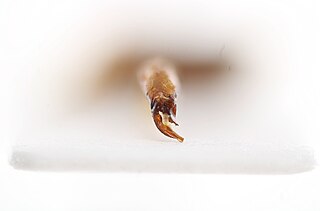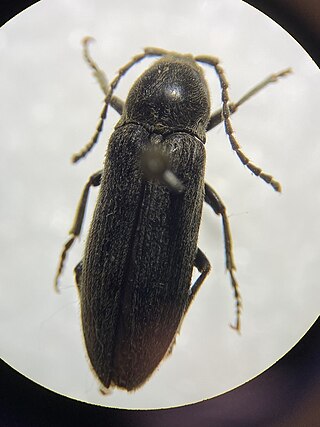
Trogidae, sometimes called hide beetles, is a family of beetles with a distinctive warty or bumpy appearance. Found worldwide, the family includes about 300 species contained in four or five genera.

Cebrionini is a tribe of click beetles from the family Elateridae; formerly ranked as a subfamily or family, they are now considered a tribe within the subfamily Elaterinae.

Chilocorus nigritus, sometimes referred to as the Malaysian ladybird beetle, is a species of lady beetle in the family Coccinellidae. It is native to SE Asia, but has been introduced for use in biological pest control in Hawaii and many parts of the world, including Europe.

Liatongus rhadamistus, or Scaptodera rhadamistus, is a species of dung beetle found in India, Sri Lanka, Laos and Thailand.
Hydroscapha monticola, is a species of skiff beetle native to India and Sri Lanka.
Coelostoma (Holocoelostoma) stultum, is a species of water scavenger beetle widely distributed in Palearctic and Oriental realms from West Pacific towards Indian Ocean, such as China, Taiwan, Andaman Islands, Myanmar, India, Indonesia, Japan, Korea, Malaysia, Mascarene Islands, Nicobar Islands, Oman, Philippines, Saudi Arabia, South Korea, Sri Lanka, Thailand, United Arab Emirates, Oman, and Vietnam.

Coelostoma (Coelostoma) vitalisi, is a species of water scavenger beetle found in China, Taiwan, Japan, India, Indonesia, Japan, Malaysia, Nepal, Singapore, Sri Lanka, Cambodia, Thailand and Vietnam.

Enochrus (Methydrus) esuriens, is a species of water scavenger beetle found in Indochina, Korea, China, Japan, Bhutan, Iran, Iraq, Nepal, India, Pakistan, Philippines, Sri Lanka, Vietnam, Sunda Island, Saudi Arabia and Australia.

Phaeochrous is a genus of beetles belonging to the family Hybosoridae. The species are widely distributed over tropical Africa, Madagascar, Aldabra, Yemen, South Asia, South-East Asia, New Guinea and Oceanian islands, as well as North and West Australia.
Melanotus punctosus, is a species of click beetle found in India, Sri Lanka, Pakistan, and Hawaii.
Anthrenus ceylonicus, is a species of skin beetle found in Sri Lanka.
Clambus ceylonicus, is a species of fringe-winged beetle endemic to Sri Lanka.
Phoberus is a genus of hide beetle in the subfamily Troginae. It was initially a subgenus of Trox before taxonomists reorganized it into its own genus. The genus is monophyletic, with all species evolved from a single common ancestor. Most beetle species in the genus live in Africa.
Phoberus cyrtus is a species of hide beetle in the subfamily Troginae discovered by Erwin Haaf in 1953.
Phoberus elmariae is a species of hide beetle in the subfamily Troginae discovered by the scientists van de Merwe and Scholtz in 2005. Like with many other beetle species, P. elmariae has not been observed again after its discovery, so all knowledge of the species comes from the 16 individual beetles van de Merwe and Scholtz saw during fieldwork.
Phoberus sternbergi is a species of hide beetle in the subfamily Troginae discovered by the scientists van de Merwe and Scholtz in 2005. Like with many other beetle species, P. sternbergi has not been observed again after its discovery, so all knowledge of the species comes from the 8 individual beetles van de Merwe and Scholtz saw during fieldwork.
Phoberus fumarius is a species of hide beetle in the subfamily Troginae discovered by Erwin Haaf in 1953.
Phoberus disjunctus is a species of hide beetle in the subfamily Troginae discovered by coleopterologist Werner P. Strümpher in 2016.
Phoberus herminae is a species of hide beetle in the subfamily Troginae discovered by coleopterologist Werner P. Strümpher in 2016.

Perothops is a genus of false click beetles in the family Eucnemidae containing 3 species. They are known as beech-tree beetles or perothopid beetles. They are small as they are only 10–18 millimeters long. It is the only genus in the monotypic subfamily Perothopinae. They are small, dark-colored beetles that are found across the United States, generally in forests. The genus was discovered by Johann Friedrich von Eschscholtz in 1836. It used to be considered a family not part of Eucnemidae. The genus's name is from Greek, translating to "maimed/crippled eye" or "eye of little necklaces/bands", referring to the placement of perothopid eyes.







